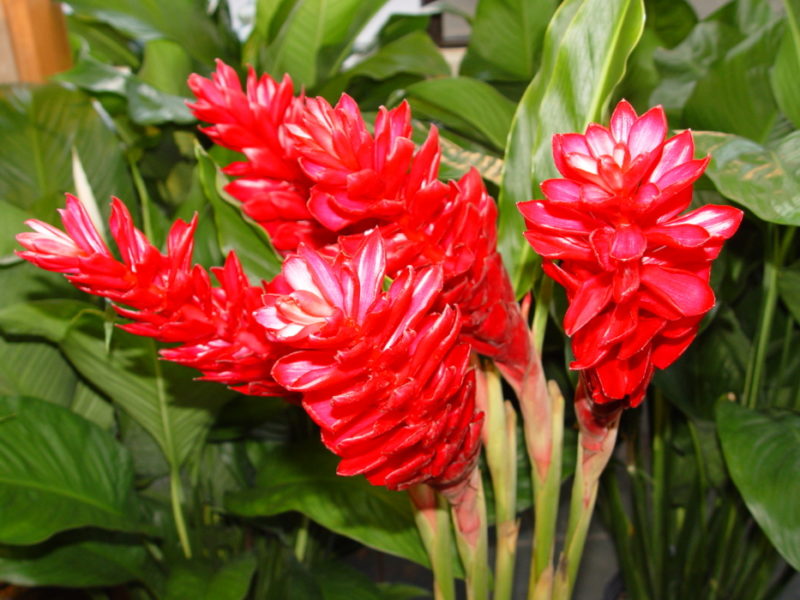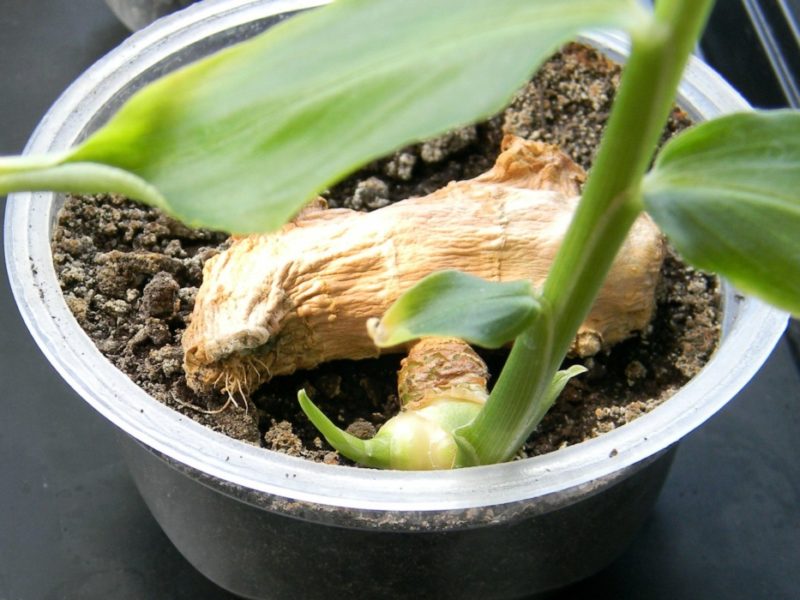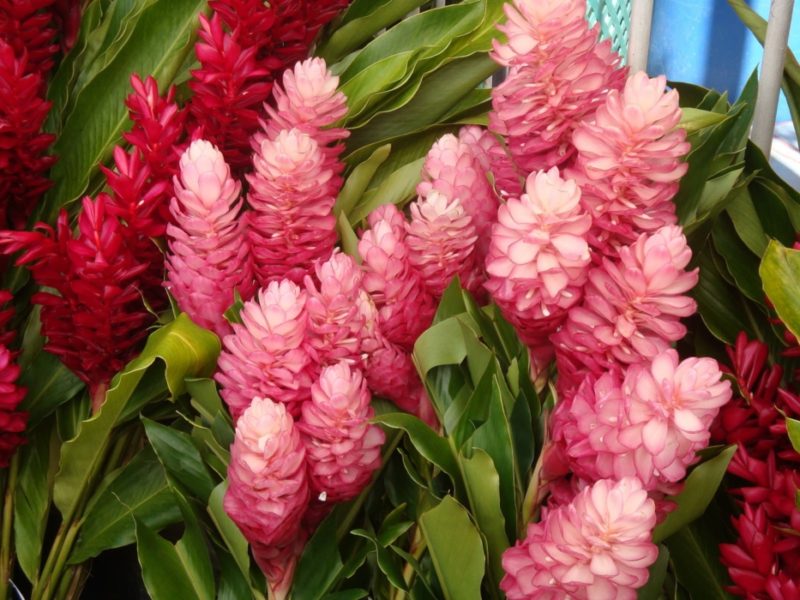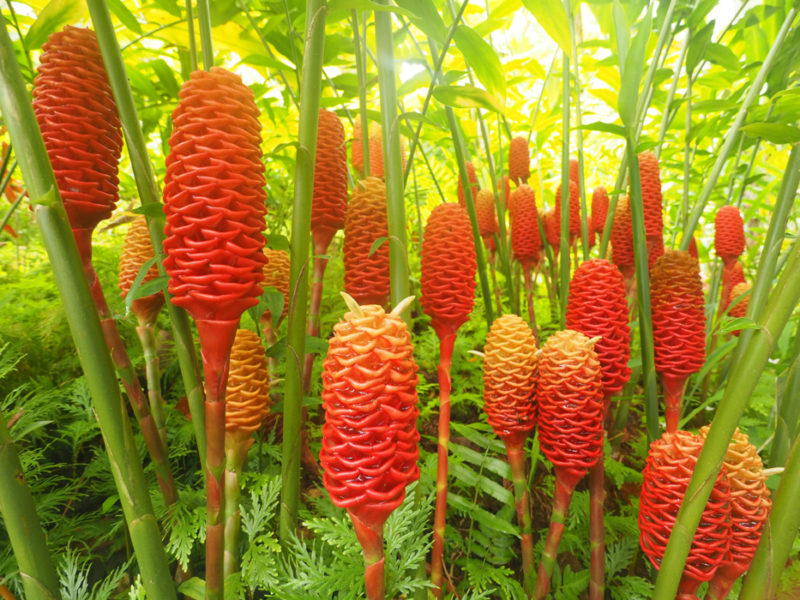Planting material for the cultivation of this tropical exotica does not need to be found in special stores, you can choose it in any supermarket or vegetable shop. And how to grow such an unusual culture at home, is it possible to harvest in the open ground, and how ginger blooms, we will tell in this article.
Material Content:
Features of growing ginger
In East Asia and India, ginger grows in abundance. 144 varieties with healing and spicy properties are known. Some of them are very decorative in bloom, and our growers grow them at home, in a greenhouse and in open ground.
An adult plant is a perennial dense herbaceous bush with a height of more than 1 m. Outwardly, ginger resembles bamboo in some way. Long narrow pointed leaves form an erect pseudostem, twisting with a tube, located next closer to the apex.
The root system is a highly branched thickened rhizome divided by lintels, which makes it look bizarre. No wonder the ancient Indian people called ginger "a horned root." The shape is a bit flattened. In the upper part there are numerous buds of growth, from where the stems appear, rare, but powerful roots grow from below.
All parts of the plant have a spicy lemon aroma and a burning taste. In the countries of the East they use for food all parts of the plant, even flowers.
Given the impressive size and subtropical origin, a special place for planting in the garden or placing a flower in the room is selected for cultivation. Ginger needs warmth and a lot of diffused light.
It is better to place it in the room on the eastern or western windowsill.
On the site, the place should be elevated and shaded from direct sunlight. Ideal for outdoor cultivation are tall, warm beds or greenhouses.
The soil is light, nutritious, well permeable to air and moisture. Ginger does not tolerate stagnation of water - the roots rot. Composition: peat + turf land + sand (2: 2: 1) or you can use the soil mixture for palm trees.
For planting, choose a rhizome with a large number of "eyes". Divide it by a jumper into several parts. In ginger, like in potatoes, each kidney is an independent viable element. You can divide the rhizome according to the “eyes”, but such a split will bloom only in the third year.
Before planting in the ground, the root is soaked in warm water for a day, so that the kidneys swell.
Do not forget to treat the planting material with potassium permanganate from fungal infections.
You can plant ginger at home all year round. Planted in shallow holes with the kidneys up (similar to planting potatoes), only the distance between the rhizomes is 15–20 cm, sprinkled with earth about 2 cm. Plantings are watered. The sprout appears after 2-3 weeks.
An important nuance! If blooming ginger is needed, then the pot for it is selected close, with lots of drainage.
Tropical Plant Care
To grow ginger in our climatic conditions, special attention and care are required:
- A microclimate as close as possible to the subtropics is created - the temperature in the summer is not less than + 25o or + 28o, and in winter not more than + 15o. It is advisable to transfer the flower to a room with a constant cool temperature regime for the winter period; it does not tolerate changes, especially sharp ones. Roots are removed from the beds and taken out to a cool room (if grown for flowering) or removed for storage and processing.
- High humidity around the plant is a prerequisite, especially on hot days. It needs frequent spraying, but does not tolerate excess moisture in the soil, it is necessary to water only after the top layer has dried. On the street to irrigate ginger is allowed only in the evening. Plants are watered and sprayed until the leaves begin to turn yellow and decay.
- "Horned root" loves top dressing, it must accumulate many useful substances. It is advisable to arrange them every 10-12 days. Ginger, grown for human consumption, is fed only with organic matter. For flowers in summer, you can use both organic and mineral compounds (it is better to alternate). In the fall, leave only the potassium-phosphorus complex. Fertilizers can also be used for vegetables or flowers. In winter, during dormancy, ginger is not fertilized.
When growing at home, protection against drafts is necessary. The lack of light in the room is compensated by artificial lighting (at least 12 hours).
How ginger blooms at home
Ginger flowering is an amazing event. Not every species of this plant blooms even in natural conditions, and only an adult 3-year-old blooms in culture. This usually happens in spring or summer.
From the root comes a long and thin peduncle with a stunning flower. When poured, the bud resembles a blooming zinnia or fir cone. Ginger flower does not fade for a long time, from 3 weeks to several months, delighting with its beauty and aroma.
The shades of the inflorescence are different: yellow, purple, red, white. It happens that one flower can combine several tones, for example, white with a purple edge.
Collector growers at home grow about seven types of ginger, for example: wonderful, purple, zerumbet. The appearance of Kasumunar is noteworthy - delicate, like orchid, white flowers bloom from under the scales of a long cone.
Or a Japanese species, the root of which, not having had time to sprout from the ground, already produces white-yellow petals, like a daffodil.
An ordinary (pharmacy) species, which our gardeners successfully grow, is considered more unpretentious in cultivation.
Flowering in the open field
It is possible to achieve flowering on the street in the middle lane if you plant rhizomes in pots or boxes in February-March. At the beginning of summer they should be planted in a bright place, but shaded from direct sunlight. And in the fall, transplant back into the pots, put them in the room and take care of them as if they were room ginger.
In southern areas with mild winters, you can not dig up rhizomes, just create insulation.
In regions with a harsh climate, ginger blooms in greenhouses and conservatories.
Collection and storage of medicinal raw materials
It is said that when ginger blooms, the rhizome partially loses its healing properties, but is suitable as a flavoring seasoning for dishes. Therefore, the period when to collect the roots depends on the purpose of cultivation.
Ginger will ripen in 8 months after planting. The signal is leaves beginning to turn yellow and fall apart.
The rhizome is removed from the ground, cleaned, cut into small roots and dried for some time in a well-ventilated room.
Young roots are easy to distinguish - they are light with a thin skin. Older adults darken and overgrow with a strong crust. They can be stored in the refrigerator or basement, wrapped in paper, frozen or prepared various spices, for example, pickle or dry.
Rhizomes of a tropical plant can also be grown in their suburban areas to use ginger for medicinal purposes and as a spice, and if desired, replenish your collection with an exotic flower.
















